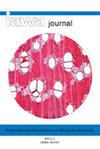Mogami Tokunai’s wood collection from Hokkaido, Japan: an early record of Ainu wood culture
IF 3.5
3区 农林科学
Q2 FORESTRY
引用次数: 1
Abstract
During the court journey to Edo (Tokyo) in 1826, the famous Japan explorer Philipp Franz von Siebold (1796–1866) met an old and wise mathematician, explorer, and ethnographer, Mogami Tokunai (1755–1836). Tokunai not only allowed Siebold to copy sensitive maps of disputed territories in Northern Japan, but also donated him a set of 45 Japanese wood samples, most of them decorated with paintings of the foliage of the trees from which the wood came, and later provided with interesting notes on their timber uses by the Ainu people in “Jezo” (or Ezo-chi, more or less equivalent with modern Hokkaido). Based mainly on earlier detailed studies by Prof. Takao Yamaguchi and Prof. Nobushige Kato, we will discuss this collection in the context of contemporary and later wood collections and its significance for forest products research in and beyond Japan. Other Japanese wood collections taken to the Netherlands by Siebold were used for the very first Ph.D. studies on wood anatomy in Leiden, and possibly also in Munich. Siebold’s most important disciple Ito Keisuke (or Ito “Keiske”, or “Keisuke Itoh”, 1803–1901) oversaw the decoration of a set of painted wood samples for teaching purposes in Tokyo in the 1880s. From the 1870s onwards, Japan was actively promoting its timber resources at World Expositions in Vienna, Philadelphia, and Paris. In the latter two venues with another special type of wood collection: sections mounted on the pages of a book, possibly inspired by a concept developed by the German forestry scientist Hermann Nördlinger.日本北海道的德川莫加美木材收藏:阿伊努木材文化的早期记录
1826年,在前往江户(东京)的宫廷旅行中,著名的日本探险家菲利普·弗朗茨·冯·西博尔德(1796-1866)遇到了一位年老而睿智的数学家、探险家和民族志学者Mogami Tokunai(1755-1836)。德耐不仅允许西博尔德复制日本北部有争议领土的敏感地图,还向他捐赠了一套45件日本木材样品,其中大部分都装饰着木材来源的树木的叶子,后来还提供了“Jezo”(或Ezo-chi,或多或少相当于现代北海道)的阿伊努人使用木材的有趣笔记。我们将主要以山口高雄教授和加藤信重教授早期的详细研究为基础,在当代和后期木材收藏的背景下讨论这一收藏,以及它对日本国内外林产品研究的意义。西博尔德带到荷兰的其他日本木材收藏品被用于莱顿的第一批木材解剖学博士研究,也可能是在慕尼黑。19世纪80年代,西博尔德最重要的弟子伊藤圭佑(或伊藤“圭佑”或“伊藤圭佑”,1803-1901年)在东京监督了一套用于教学目的的彩绘木样的装饰。从19世纪70年代开始,日本在维也纳、费城和巴黎的世界博览会上积极宣传其木材资源。后两个场地有另一种特殊类型的木材收集:安装在一本书的页面上的部分,可能受到德国林业科学家赫尔曼Nördlinger开发的概念的启发。
本文章由计算机程序翻译,如有差异,请以英文原文为准。
求助全文
约1分钟内获得全文
求助全文
来源期刊

IAWA Journal
农林科学-林学
CiteScore
3.40
自引率
15.80%
发文量
26
审稿时长
>36 weeks
期刊介绍:
The IAWA Journal is the only international periodical fully devoted to structure, function, identification and utilisation of wood and bark in trees, shrubs, lianas, palms, bamboo and herbs. Many papers are of a multidisciplinary nature, linking
 求助内容:
求助内容: 应助结果提醒方式:
应助结果提醒方式:


